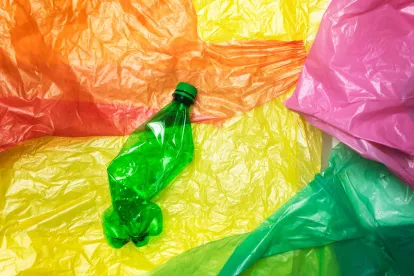In 2021, new federal and California regulations were established to protect public health and environments from the impacts of Per- and Polyfluoroalkyl substances (PFAS). Clients in industries that utilize PFAS, owners of PFAS-contaminated properties, and clients selling products containing PFAS in California, should be aware of the changing regulatory environment.
About PFAS
PFAS are a diverse group of humanmade chemicals used in a wide range of consumer and industrial products. Many PFAS are resistant to grease, oil, water, and heat, and have been used since the 1940s in a variety of industrial and consumer product applications including stain- and water-resistant fabrics, non-stick cookware, carpeting, cleaning products, paints, and fire-fighting foams. Approximately 650 kinds of PFAS are currently in commerce under the Toxic Substances Control Act (TSCA). Certain PFAS are also authorized by the Food & Drug Administration for use in cookware, food packaging, and food processing equipment. While PFAS use is widespread, the U.S. Environmental Protection Agency (EPA) has identified only about six to eight facilities that produce PFAS feedstock, and most significant PFAS discharges are found in a handful of industries, including PFAS production/ processing, metal finishing, airports, pulp and paper production, landfills, and textile and carpet manufacturing.
Recently, much scientific and regulatory attention has been focused on PFAS and their tendency to remain intact and accumulate in the environment and human bodies, for which they have earned the nickname “forever chemicals.” While some types of PFAS are better-studied than others, evidence is increasing that at least some PFAS have the potential to cause serious health problems such as cancer and reproductive harm. PFAS-containing products are regularly disposed of via landfill or incineration, but PFAS’ inability to break down in the environment means that the removal of PFAS from contaminated areas can create additional PFAS-contaminated waste. Currently, such waste is largely unregulated, but growing awareness of the health hazards posed by PFAS in the last few years has led to increased attention from federal and state regulatory bodies, and it is expected that regulation of both PFAS and PFAS-contaminated waste will continue in the near future.
Federal Regulation
In April 2021, EPA established the EPA Council on PFAS with the intent to develop a strategy to protect public health and the environment from the impacts of PFAS. On October 18, 2021, EPA released a “PFAS Strategic Roadmap” which outlines EPA’s approach to regulating PFAS. Because PFAS remain in widespread use in U.S. commerce, EPA anticipates regulations focused not on only cleaning up the downstream effects of PFAS pollution, but also looking upstream to prevent new PFAS contamination from entering air, land, and water. In its Roadmap, EPA states its intention to “impose appropriate limitations on the introduction of new, unsafe PFAS into commerce and. . . use all available regulatory and permitting authorities to limit emissions and discharges from industrial facilities.”
In January 2022, EPA submitted its initial plan to the White House Office of Management and Budget (OMB) to designate two PFAS, Perfluorooctanoic Acid (PFOA) and Perfluorooctane Sulfonic Acid (PFOS), as hazardous substances under the Comprehensive Environmental Response, Compensation, and Liability Act (CERCLA). Once OMB finalizes its review, EPA will publish a proposed rule in the Federal Register for public comment. A final rule is expected in Summer 2023. Once finalized, the rule will require facilities to report on PFOA and PFOS releases and allow for cost recovery or contributions for costs incurred related to cleanup of such releases.
EPA also plans to publish a national PFAS testing strategy, ensure a robust review process for new PFAs using the TSCA New Chemicals program and review previous PFAS decisions made under that program, restrict abandoned PFAs and uses, and enhance PFAS reporting under the Toxics Release Inventory. EPA has also committed to addressing and ultimately limiting PFAS in industrial wastewater discharges.
California Regulation
California is one of several states that are currently developing PFAS restrictions. Bans on PFAS in food wrappers, children’s products, and firefighting foam will take effect in 2023. Additionally, proposed legislation would prohibit the sale of clothing or textiles containing PFAS and would require manufacturers to use the “least toxic alternative” when replacing PFAS in those products.
California has also taken steps towards regulating the amount of PFAS in drinking water. In the years leading up to 2021, the State Water Resources Control Board’s Division of Drinking Water adopted “notification levels” and “response levels” for PFOA and PFOS that are applicable to public water supply purveyors. However, there is not yet a formal federal or California state drinking water standard (known as a maximum contaminant level or “MCL”) for any PFAS compounds. The rigorous and time-consuming process for the eventual adoption of a state MCL for PFOA and PFOS is underway and is expected to continue in 2022.
Proposition 65
In 2021, California indicated its intent to regulate certain PFAs under the Safe Drinking Water and Toxic Enforcement Act of 1985 (Proposition 65) which lists chemicals known to the state to cause cancer or reproductive harm. On May 3, 2021, California’s Office of Environmental Health Hazard Assessment (OEHHA) identified PFOA as a carcinogen and added it to the Proposition 65 list. OEHHA did the same for PFOS on December 24, 2021. Both chemicals had previously been regulated under Proposition 65 for reproductive toxicity. Among other things, a chemical’s listing under Proposition 65 requires any product sold in California that potentially exposes consumers to the listed chemical to bear a clear and reasonable warning. State regulation of additional PFAS is anticipated in 2022. OEHHA has already selected two additional PFAS, perfluoronanoic acid and perfluoroundecanoic acid for evaluation for reproductive toxicity.



 />i
/>i
